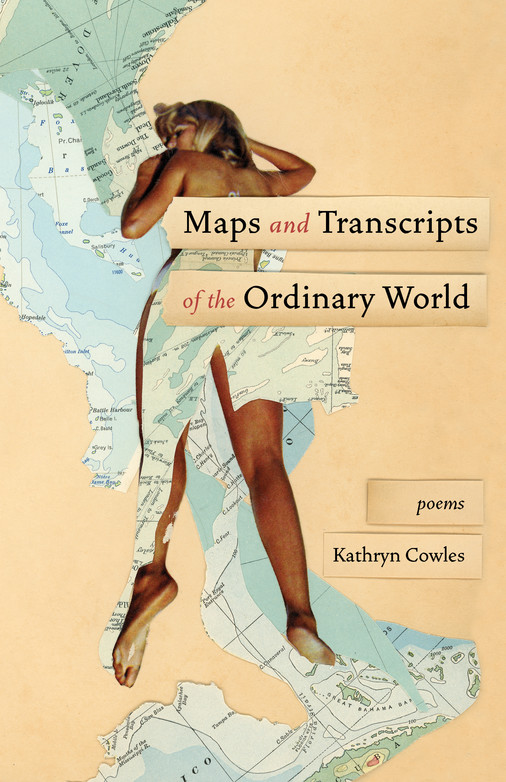
Kathryn Cowles’s second book, Maps and Transcripts of the Ordinary World, contends with the formalism of poem as object, in the sense that a poem holds a literal position in space and time. Her eminently accessible, readable collection belies a circular and circling complexity that questions the role of language as a deictic tool in making sense out of a reality that exists with or without us.
The first poem in the collection, self-consciously titled “Origin Story,” contains that brand of imaginative wonder that readers of poetry might find familiar. The speaker reaches back to antiquity, certainly conjuring Sappho. Here too, the poem enacts its essential role as wayfinder, as a literal map constructed from the symbols of language:
I stepped out of the blue paper
of map water
onto an island in Greece
Although, a few lines later, the simplicity of this metaphorical action is unraveled:
sun rose and I wrote
sun rose
and then I wrote that I wrote it,
As in many of these poems, the present moment of writing is interwoven into the poem itself. Thus the poem, in a kind of performative sweep, writes itself over and over again. Many of Cowles’s poems declare themselves into this kind of self-perpetuating existence:
And my rugged circles are conceptual, darling.
All they do
is point fingers at loosened hills.
Although Cowles’s voice remains both ordinary and elaborate in this way, the collection’s field of view widens and envelopes a larger circle of concerns and catalysts, including Cowles’s own temporary relocation to Ohio. Here, she finds herself disoriented, perplexed by landmarks she cannot discern nor understand. “Plain,” the section of the book that grapples with this unfamiliar landscape, opens with the serial poem titled “I am on a plane”(pun intended?), which narrates an all-too-familiar experience. Deliberately mundane in its details (“I choose peanuts/ she gives me two packages/ 12 g each, calories from fat 60”), and enjoyable precisely because commiseration is pleasure, this poem calls forth the strange emptiness at the center of what language cannot describe.
This section, too, seems to contain the largest density of Cowles’s postcard poems, which are exactly what they sound like: photographs that are overlaid with cut-and-pasted text.
These multimodal poems enhance the role of language as labeler, as a symbol which directs attention to something else beyond itself. The typed text on photos of silos, grain elevators, and farmland serves to not only label the objects in the photos, but also to gesture towards a constantly shifting inner world.
The postcard poems inevitably conjure up the early 2000s “PostSecret” phenomenon, a community art project to which people anonymously sent postcards that more often than not expressed their deepest, darkest secrets. Cowles’s simplistic cut-and-paste method of superimposing text on photos certainly evokes that voyeuristic confessionalism, but also contradicts it with language that is nearly anti-poetical. Text labels objects in the photos (“water boat water/ water water water water boat”) and sometimes transcends them.
Many other of Cowles’s poems sustain this thread of simplicity. Some (“Origin Story,” “Transcript of birds,” “Interview,” “Fieldguide”) are titled in such a direct, prosaic way that I expect the poems themselves to be clarifying, perhaps unsurprising. However, Cowles repeatedly undermines this set-up by creating a quietly incandescent world of pastoral subversion, where poems like “Three poems called ‘The basil’” enact a resurrection, a hopefulness among the disorienting landscape where details never really seem to make sense together.
In many places, Cowles uses her gift for enjambment to quicken and slow the waves of internal logic, to suggest that something is missing despite language’s best efforts. Short, punchy poems like “Shower Water” showcase her strength for directly capturing the overwhelming paradox of being a feeling human in a world that will exist despite you:
stood in the shower today
let water drip off my lids
it wasn’t crying
it was shower water
the top of my eyelids
if I moved back more water
if I moved forward less
The final handful of poems attest to Cowles’s deliberateness in exploring her “ordinary world” with complex, breathy, and surprising forms. A poem called “Map Legend” appears pointedly near the end of the book. A rural glossary merged with a dialogue, it is perhaps the least literal map in the entire book. The final poem, faithfully titled “Directions,” epitomizes the function of deixis in constructing meaning from words (like the refrained “here”), that without context, are essentially meaningless. The poems themselves are hatching modalities that bounce between the matter of language and the matter of the real world. Cowles’ collection is slippery, elusive, but also in essence, inexpressibly familiar:
I have tried to write it down. The ordinary world. When I did, and when I didn’t, it was always still there.
***
Maps and Transcripts of the Ordinary World
by Kathryn Cowles
Milkweed Editions; 88 p.
Follow Vol. 1 Brooklyn on Twitter, Facebook, and sign up for our mailing list.
